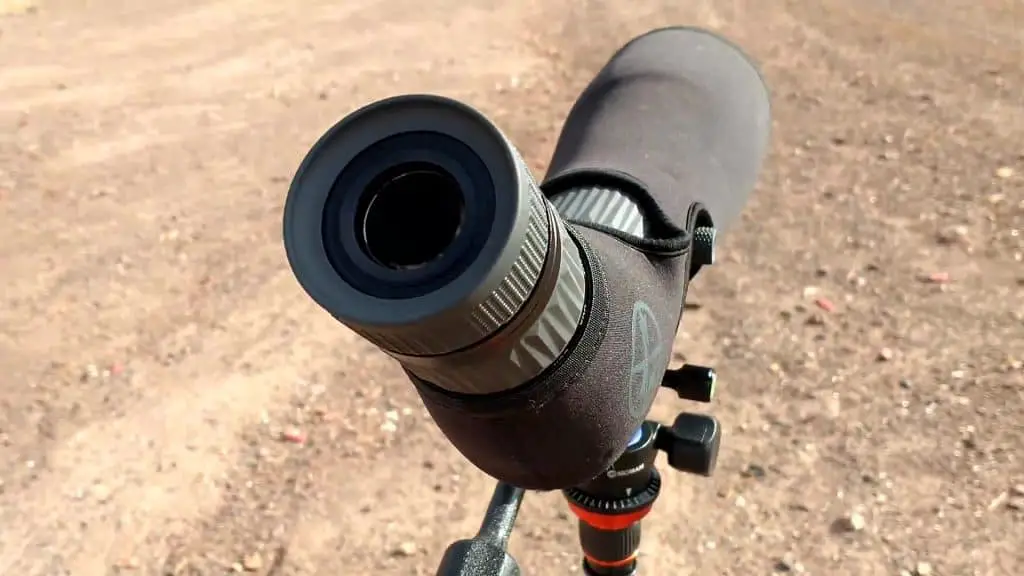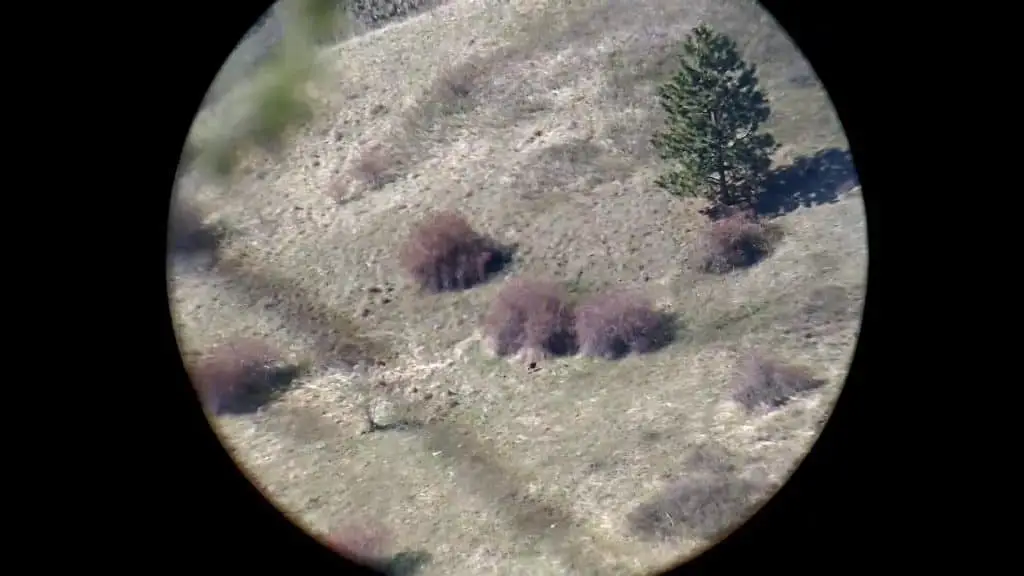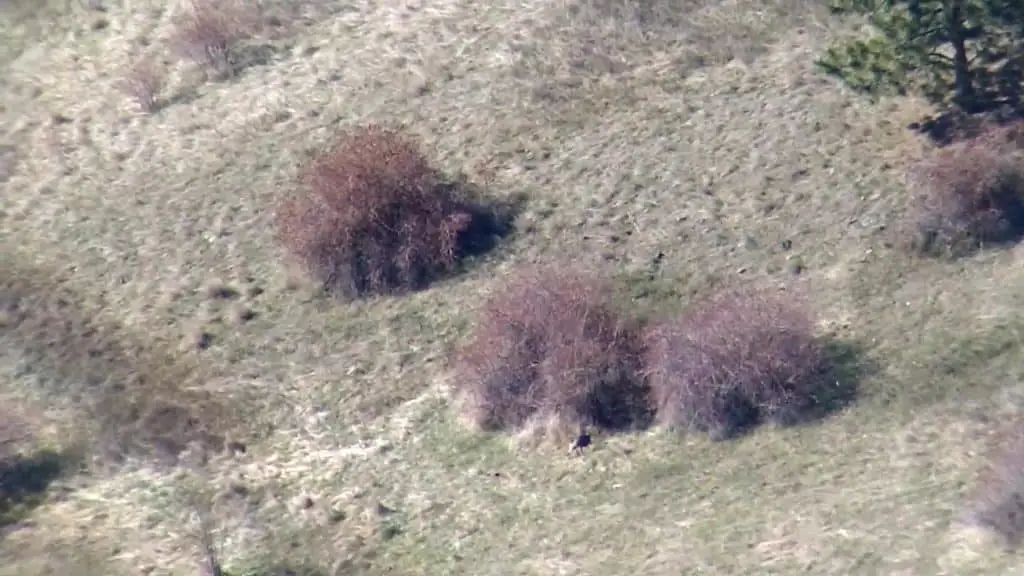In 2020 Leupold came out with a HD spotting scope under $500 (check price on Amazon), the SX-2 Alpine HD. I’d been waiting and looking for a good spotting scope at an affordable price for a couple of years and this looked like it was my chance. I purchased the 20-60 x 80 mm version and have been using it in my hunting, scouting, and shooting endeavors for the last few months. I’ve found it to be a great spotting scope that stacks up well against more expensive competition.
About the SX-2 Alpine HD
The SX-2 Alpine HD comes in two models. Both have a variable zoom of 20-60 one model has an 80 mm objective lens diameter and the other a 60 mm. The 60 mm version is 14.3 inches long and weighs 60 ounces. The 80 mm version is two and a half inches longer than the 60 mm version and 7 ounces heavier. Both have an angled eyepiece. There is also a price difference between the two models. The 60 mm model retails for about $400 and the 80 mm for about $500. The lengths and weights of these scopes are very comparable to other spotting scopes with the same magnification and objective lens size.
The SX-2 is waterproof and fogproof and sports Leupold’s proprietary lens coatings which reduce glare and improve low-light visibility. The scope comes with an integrated sunshade and a soft case.

Testing the SX-2 Alpine HD
After doing some research I purchased the SX-2 Alpine HD 20-60 x 80 mm. I went with the larger objective lens because I wanted to use it for digiscoping and my research indicated that the additional light-gathering capabilities of the 80 mm lens would produce better video and photos in low-light situations.
I tested the scope in a variety of situations. During the 2021 spring bear hunt, I spend a lot of time glassing distant canyons during many different light and weather conditions. I was looking through the scope early in the morning, late in the evening, during heavy wind, rain, snow, and midday sun. Additionally, I used the SX-2 to observe impacts while zeroing my rifle, doing long-range target practice (out to 1000 yards), and checking out local birding hotspots.
As I used the scope I made notes of its performance, the features I liked and didn’t like, and anything else that potential buyers might like to know about. The rest of this article summarizes my findings. The SX-2 doesn’t have the high-end ED glass that comes on more expensive products.
What I Liked About the SX-2
My favorite thing about the SX-2 is that the feature set makes it feel like a high-end product. The SX-2 looks and feels nearly exactly the same as the high-priced SX-4 and other scopes (like the Vortex Razor), for that matter. This is a quality spotting scope. When glassing in low-light conditions it left nothing to be desired. I could easily see well enough to identify targets and wildlife even before shooting light started and clear visibility was maintained until after legal shooting light was over.
The scope is easy to focus and the zoom adjusts easily. The eye relief on the SX-2 is excellent. Combined with the twist-up eyepiece, it’s easy to configure the scope for comfortable viewing for any user. My wife often has a hard time getting a good picture through spotting scopes, but had no trouble with the SX-2.
Potential Drawbacks to the SX-2
The biggest drawback I found to the SX-2 will only apply if you’re interested in using your phone or a camera to capture images or video through the scope. There is a small, raised edge around the eyepiece of the SX-2 alpine. I found that this edge lifts the camera far enough away from the eyepiece that it requires a little extra zoom to remove vignetting around the edge of the camera view. This can make images and video come out a little grainy and be too zoomed in for closer objects. Otherwise, I found the SX-2 to perform extremely well.
I use the PhoneCam universal phone adapter with a Moto G Power. It’s possible you may have better luck with a different phone and/or adapter combination
I previously mentioned that the SX-2 Alpine uses a lower quality of glass than higher-end scopes. For me this isn’t a big deal. If I wanted a top-of-the-line scope then I would dish out the money for the product with the best of everything.
At higher zoom levels (above about 40x) you can start to see chromatic aberration in some instances. For me this was most noticeable on targets where black and white edges met. Any optic is going to have some degree of chromatic aberration and the SX-2 wasn’t very bad. I had to look for it to see it. However, some of that aberration would be removed with higher-end glass.
The other downside is that the 80 mm model is a little large and a little heavy. That isn’t specific to this product, just spotting scopes in general. So if size and weight are a big factor for you I’d recommend the smaller 60 mm model.



Would I Recommend the Leupold SX-2 Alpine HD
The Leupold SX-2 Alpine is a very functional spotting scope and compares well with other spotting scopes that cost twice as much or more. Given Leupold’s lifetime warranty and stellar reputation, you can count on this scope to be with you and perform well for a long time. If you are looking to get a good spotting scope without spending $1000 (or more) I would recommend this scope. The glass quality isn’t as good as the higher-end scopes, but if you haven’t spent a lot of time looking through high-quality optics you probably won’t notice the difference.
For me, the $500 savings is worth what the scope lacks in premium, top-of-the-line materials. I think this is a great buy for the budget-conscious sportsperson.
If you’re planning to do a lot of digiscoping you should test out this spotting scope with your camera and adapter before you make the purchase. I was able to get pictures and video just fine, but had to zoom in with my phone to avoid excessive vignetting. I haven’t had this issue with other spotting scopes and I believe it’s due to the small raised edge on the eyepiece.

